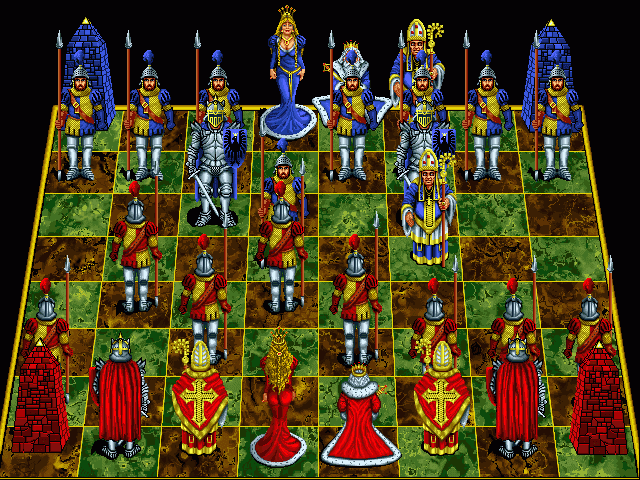A staple of RPGs are character classes. A few modern games have let the player
accumulate skills without limit (Elder Scrolls series), but the majority of
them lock the player abilities and progression to a fantasy archetype (warrior,
rogue, mage, etc). Of course, they inherited
from Dungeons and Dragons, which codified the rules and powers from the old
myths and fantasy classics (Greek mythology, Conan the Barbarian, Lord of the
Rings).
So classes make sense from a narrative perspective, but what
about from a game play perspective?
Particularly for a grid-based tactical combat game? For that, we can look at the granddaddy of
all grid-based combat games: Chess.
In chess, every "class" can kill any other,
although their method of attacking varies.
They also have different move sets.
What makes chess interesting is that there isn't a straight curve of
power. In some situations a knight is better than a queen, a pawn over a rook.
One way I've been looking at character classes is through
their strengths and weaknesses, in relation to the grid-based tactical combat.
Here's the breakdown:
mobility - how can a character move around the board
(charges, teleports, diagonal)
range - how far away a character can attack (ranged weapons,
spells, cleave, AoE)
damage - how much raw damage the character can inflict
(crits, bleeds, poison)
survivability - how much damage a character can take (armor,
resistance, regen)
utility - how can the character alter itself, allies,
enemies or the board for the other categories (slow, haste, web, stun, shield)
In chess, the only attributes in play are mobility and
range. You could argue the
"castling" move is sort of a utility of the rook. But mostly, all the pieces have the same
damage and survivability.
Lots of RGPs try to create balance by giving all the
character classes the same amount of power.
In a way, you end up with a single character classes "skinned"
to look like a mage or warrior. Chess
blatantly has different powers in the pieces.
A queen can completely dominate the board. But a knight can jump other pieces; a pawn
can reach the end of the board and ascend to any other piece. A chess game fought entirely of queens would
be dull.
So what I'd like to do in my RPG is take some tips from Chess
and design classes that play in very different ways, and possibly aren't even
balanced in relation to each other. But
in the context of grid-based tactical combat, each class would have use.
What I did was take the five attributes above and try to
find some interesting combinations. A
lot of them end up as the classic character tropes from RPGs (heavily armored
warrior, agile rogue, weak mage nuking from afar), but there some interesting
ones as well.
mobility
|
range
|
damage
|
survive
|
utility
|
class?
|
1
|
1
|
0
|
0
|
0
|
fast archer
|
1
|
0
|
1
|
0
|
0
|
teleporting rogue
|
1
|
0
|
0
|
1
|
0
|
armored sprinter
|
1
|
0
|
0
|
0
|
1
|
bard
|
0
|
1
|
1
|
0
|
0
|
sniper
|
0
|
1
|
0
|
1
|
0
|
turret
|
0
|
1
|
0
|
0
|
1
|
buffer
|
0
|
0
|
1
|
1
|
0
|
blademaser
|
0
|
0
|
1
|
0
|
1
|
caster
|
0
|
0
|
0
|
1
|
1
|
armored cleric
|


No comments:
Post a Comment